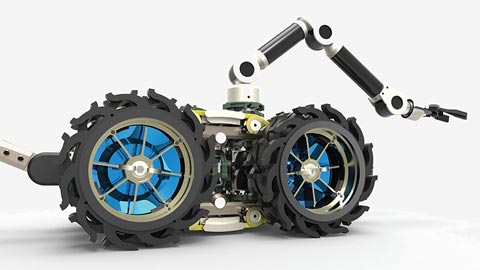Robosynthesis Modular Platform incorporates clever components that assemble to form a range of reconfigurable robots
Robosynthesis Modular Platform incorporates clever components that assemble to form a range of reconfigurable robots

Inspired by the natural world
As determined as a salmon swimming upstream, as robust as an armadillo, it can climb and creep like a gecko. It has the aptitude of a chimpanzee to utilize tools and the capacity of a cockroach to withstand extreme and hazardous environments. Simple, yet sophisticated, it is a reconfigurable robot from Ross Robotics, and it can be deployed to undertake numerous tasks across a wide range of industries.
What differentiates the Ross Robotics approach is the design and production of modules that fit together and can be configured in a variety of ways. Scalable and uniquely customizable, the Robosynthesis® Modular Platform can be delivered “off the shelf.” Philip Norman, co-founder and chief technical officer (CTO) of the company, explains, “Our robots might look quite different but they use exactly the same parts, which gives the potential to assemble and reassemble on-demand for different purposes.”
Every part is independent of everything else, yet can be locked to one or more other parts and still be moved into a new position. Unlike building-block systems that only allow pieces to connect to each other in two or three directions, the Robosynthesis Modular Platform has no such constraints. The principle of axial and orthogonal re-positioning is enshrined in the original geometries of this modular system. Components can be fitted together at any angle, and the composite angles thus created are infinitely adjustable.
From concept to clarity with Solid Edge
The Robosynthesis Modular Platform was conceived at the start of the 21st century when Norman was living in France and exploring the concept of a new construction toy. He mentioned this to an engineer friend who introduced him to Solid Edge. “It was a revelation,” says Norman. “What had begun as a rather dreamy intellectual idea became sharp and clear. I picked my way into Solid Edge and found more and more functionality. It was a watershed moment when I realized I could simply sketch, then extrude to create a 3D shape. I went on to discover that I could put bits together and create an assembly or place parts in a library and take them out later. There was a sense of pure delight when I updated a part I’d built and it updated in the assembly as well. To top all of this, I could break up an assembly and go back to where I was. There are clearly lots of little ‘Eureka!’ moments as a user becomes quicker and more confident.”
As his ideas evolved, Norman went on to consider, then discard, an architectural application. Education was the main theme for several years as he funded further development by providing school and technical college students with an opportunity to study mechatronics and prototyping through programs at IFMA, the advanced mechanical engineering institute in Clermont-Ferrand. A suggestion from a family member then led Norman to modular robotics. “I realized that I needed to drive this to a tangible outcome, and I became really focused,” he says. “The main challenge was to create and build one part that could join components together and rotate.”
